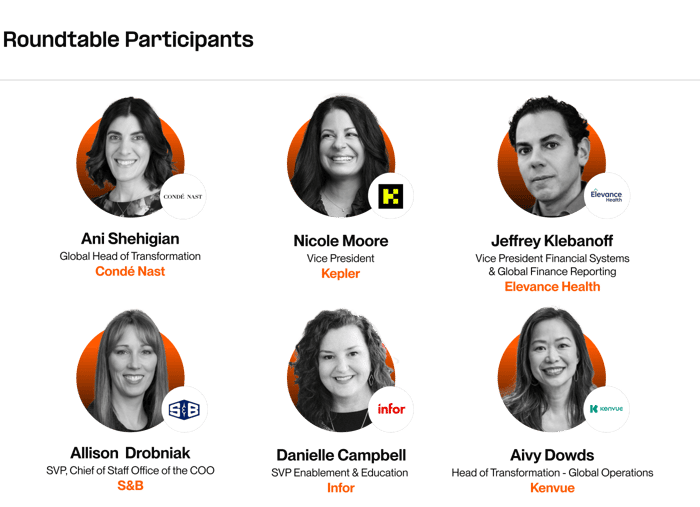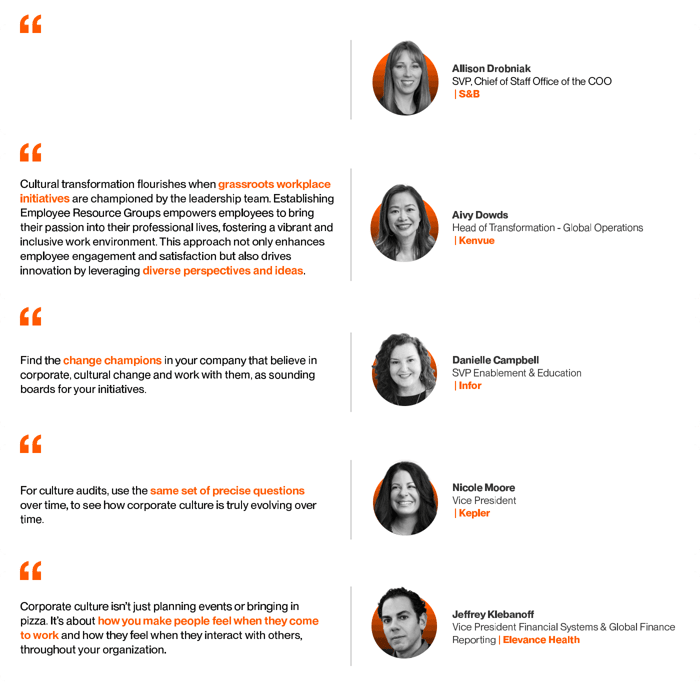Cultural transformation within organizations demands adept leadership strategies to foster sustainable change. This executive brief encapsulates insights from an Executive Council for Leading Change (ECLC) roundtable discussion, shedding light on effective approaches, tools, challenges, and tactics in leading change amidst cultural transformation.
This roundtable was held on May 10th, 2024.

4 Strategies for Leading Change Around Cultural Transformation
Change leaders were asked which strategies they found most effective when initiating cultural change. Here are the most popular responses and insights from the discussion:
Clear Communication of Vision and Values From Top Leadership
Effective cultural transformation hinges upon transparent communication of vision and direction from top leadership. Beyond corporate values written on a webpage, senior executives must embody organizational values, fostering alignment and ownership across all levels of the organization.
Top-Down Leadership and Communication
Employing diverse communication channels, including virtual town halls and videos, helps to spread important messages around change, from senior executives to the rest of the organization. By taking into account different communication preferences and different messaging around a change, cultural transformation is more likely to occur.
Early Identification and Management of Potential Resistors
Some change leaders pointed out the difficulty of getting middle management onboard, during a cultural transformation. Involving middle management early in transformational initiatives mitigates resistance and garners valuable insights for implementation. By soliciting feedback and integrating their perspectives, organizations foster an overall culture of collaboration and change readiness.
Employee-Driven Change Initiatives
Recognizing culture as a collective endeavor, change leaders underscored the significance of fostering connections among employees. Change leaders cited the establishment of Employee Resource Groups (ERGs) as a successful initiative to drive cultural transformation. ERGs transcend superficial perks, such as catered lunches or recreational amenities in an office, by providing avenues for employees to engage in meaningful projects aligned with their personal values. This not only cultivates camaraderie but also engenders a profound sense of purpose, thereby deepening their relationship with other workers and their organization.
3 Tools and Techniques for Effective Cultural Change
Change leaders were asked which tools or techniques they found to be indispensable for driving a cultural transformation. Here are the most popular responses and insights from the discussion:
Continuous Learning and Development Programs for Employees
Investing in employee growth cultivates a culture of adaptability and innovation, aligning organizational objectives with individual aspirations. By framing cultural change as something that is mutually beneficial for the organization and for its workforce, new avenues of growth are created and maintained.
Digital Platforms for Collaboration and Knowledge Sharing
Leveraging digital platforms facilitates knowledge sharing and consensus-building across diverse teams, essential for fostering a cohesive cultural identity. That’s where change-enabling platforms (like Tigerhall) give corporations opportunities to not only share knowledge and approaches but also collaborate and reach a consensus on different topics, across different departments.
Data Analytics and Metrics to Guide and Justify Decisions
By using data in cultural transformation initiatives, the concept of changing a culture goes from a qualitative, hard to pinpoint need to a qualitative, measurable over time objective.
5 Successful Approaches and Tactics for Leading Sustainable Change Around Cultural Transformation
Change leaders were asked what approaches they used to ensure the long-term success and integration of new cultural elements. Here are the most popular responses and insights from the discussion:
Reinforcement Through Leadership Behaviors and Role Modeling
Senior leadership’s commitment to embodying cultural values reinforces organizational identity and sustains change momentum over time. This commitment serves as a beacon guiding employees through the evolving cultural landscape, inspiring confidence and trust in the journey.
Development of a Culture Champion Network Across the Organization
Nurturing a network of change champions into action-oriented groups fosters collective accountability and actionable feedback, driving sustained cultural change. By empowering these champions, organizations cultivate a grassroots movement that permeates every level of the organization, amplifying the impact of cultural initiatives and ensuring alignment with overarching goals.
Ongoing Culture Audits and Alignment Checks
Regular audits enable organizations to assess cultural alignment and adapt strategies accordingly, ensuring continued relevance and resonance. By asking the same questions over time, change leaders can compare and contrast results between audits, to measure how the culture of their organization is evolving over time.
Promoting Success Stories
By selecting certain change advocates within the organization, change leaders can create success story narratives around these advocates and create poster children of change. This creates a safe, relatable narrative around a change initiative.
Maintaining Internal Knowledge Bases
Establishing and frequently updating knowledge repositories streamlines new employee onboarding and reinforces overall cultural integration efforts, from their first day on the job.
4 Common Challenges Faced
ECLC members were asked to identify the biggest obstacles they typically face during a cultural transformation. These were the most popular answers:
Resistance from Middle Management
Middle managers are often very aware of what has worked well for them in the past but are often not completely aware of where the company is heading. Thus, it becomes important to involve middle management early and frame change initiatives from their perspective during cultural changes, to facilitate buy-in and minimize resistance. This helps to bridge the gap between the plan of cultural transformation and what cultural transformation looks like for frontline workers, in their everyday work.
Aligning Diverse and Often Conflicting Stakeholder Interests
Balancing conflicting stakeholder interests requires nuanced strategies that promote cultural unity without stifling innovation. That’s where striking a balance between cultural unity and individual thought becomes important; when cultural unity is imposed, work might be done more rapidly as everyone is on the same page yet there is a risk of losing out on important opportunities due to cultural blindspots.
Scaling Change Initiatives Across Global and Diverse Teams
Overcoming technological barriers and cultural differences necessitates tailored approaches to engage diverse, geographically dispersed teams. Implementing robust communication channels and culturally sensitive strategies fosters inclusivity and ensures that transformational efforts resonate across varied contexts, promoting cohesive cultural change on a larger scale.
The Difficulty in Defining Culture
A company’s culture happens to be more than its espoused values or its employee benefits; it is an amalgamation of different elements that brings employees together and that distinguishes one company from another. As such, it can be difficult to easily capture and express its scope, then decide how it must evolve.
5 Notable Quotes from the Roundtable

Conclusion
Leading change amidst cultural transformation demands a multifaceted approach, encompassing clear communication, strategic utilization of tools, and a commitment to addressing inherent challenges. By embracing these strategies and leveraging collective insights, organizations can navigate complexities and foster enduring cultural transformation.
The Executive Council for Leading Change
The Executive Council for Leading Change (ECLC) is a global organization that brings executives together to redefine the landscape of organizational change and transformation. Our council's aim is to advance strategic leadership expertise in the realm of corporate change by connecting visionary leaders. It's a place where leaders responsible for significant change initiatives can collaborate, plan, and create practical solutions for intricate challenges in leading large organizations through major shifts.
In a world where change is constant, we recognize its crucial role in driving business success. ECLC’s mission is to create a community where leaders can excel in guiding their organizations through these dynamic times.
Interested in joining ECLC? Learn the membership criteria and sign-up here.
To download this executive brief, click here.

